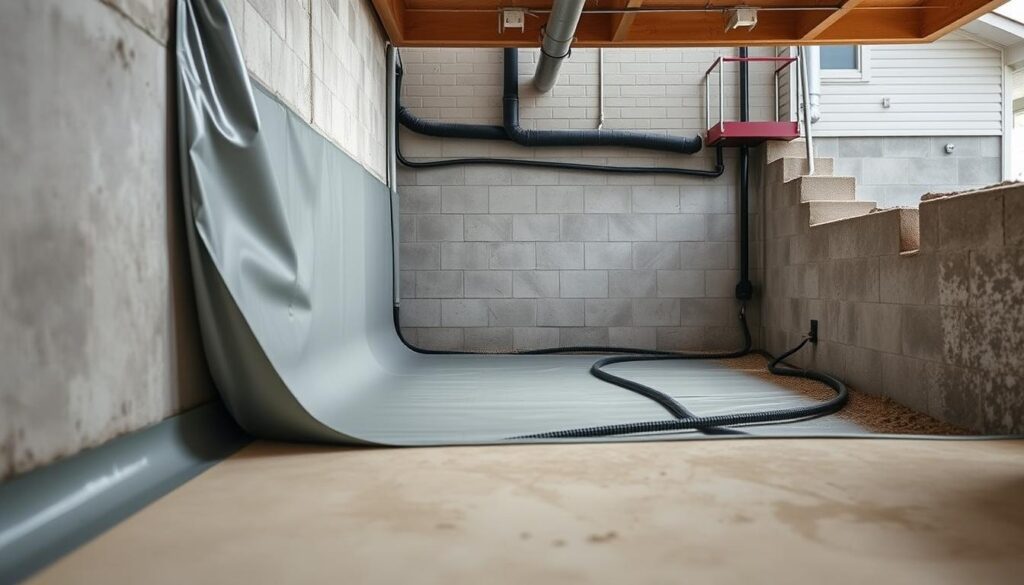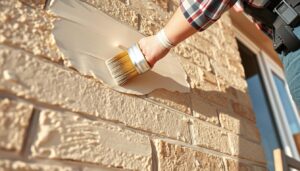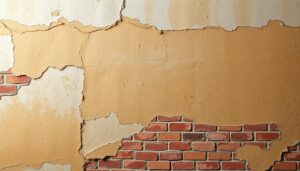Are you tired of dealing with damp and musty basements that seem to be a breeding ground for mould and mildew? Are you wondering if there’s a way to transform this neglected space into a dry and habitable area?
Below-ground structures like basements are prone to water ingress due to the surrounding soil and groundwater. A robust waterproofing system is essential to prevent moisture from seeping into your home.
Effective tanking and waterproofing methods can protect your basement from water damage, creating a valuable living space. In this guide, we’ll explore the most effective waterproofing solutions available in the UK market.
Key Takeaways
- Understand the importance of waterproofing your basement walls.
- Learn about the challenges of below-ground structures.
- Discover the difference between various tanking methods.
- Explore effective waterproofing solutions for basement walls.
- Gain insights into choosing the right waterproofing system.
Understanding Basement Waterproofing Needs
Understanding the needs of basement waterproofing is essential for preventing water damage. Below-ground basement structures are prone to leaks, and seepage can cause significant problems if not addressed correctly.
Common Basement Water Issues in the UK
The UK’s climate, with its frequent rainfall, creates unique challenges for basement waterproofing. Common issues include hydrostatic pressure, rising damp, and lateral water penetration, which can lead to water ingress and subsequent damage.
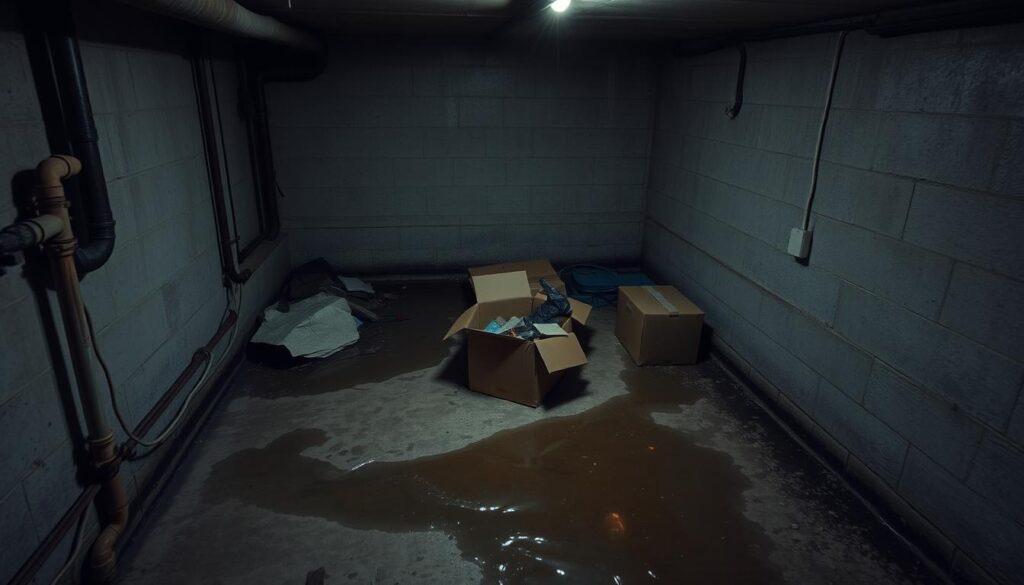
The Importance of Proper Waterproofing
Proper tanking and waterproofing systems are crucial in creating an effective barrier against moisture. The consequences of inadequate waterproofing can be severe, including structural damage and mould growth. Adhering to British Standards (BS8102) for basement waterproofing is vital.
| Issue | Consequence | Solution |
|---|---|---|
| Water Ingress | Structural Damage, Mould Growth | Proper Tanking, Waterproofing System |
| Hydrostatic Pressure | Dampness, Water Seepage | Damp Proofing, Comprehensive Waterproofing |
Types of Basement Waterproofing Systems
Understanding the different types of basement waterproofing systems is vital for homeowners looking to protect their properties from water damage.
Barrier Protection: Type A Waterproofing
Type A waterproofing involves creating a barrier to prevent water from entering the basement. This is achieved through the application of tanking slurry or membranes, providing effective protection against water pressure.
Cavity Drainage Systems: Type C Waterproofing
Type C waterproofing utilises a cavity drainage system, where a membrane is installed to create a drainage cavity behind it. Water that seeps in is directed into channels and flows to a drainage point, keeping the living area dry.
| Waterproofing Type | Method | Benefits |
|---|---|---|
| Type A | Barrier protection using tanking slurry or membranes | Effective against water pressure |
| Type C | Cavity drainage system with membrane installation | Directs water to drainage points, keeping living areas dry |
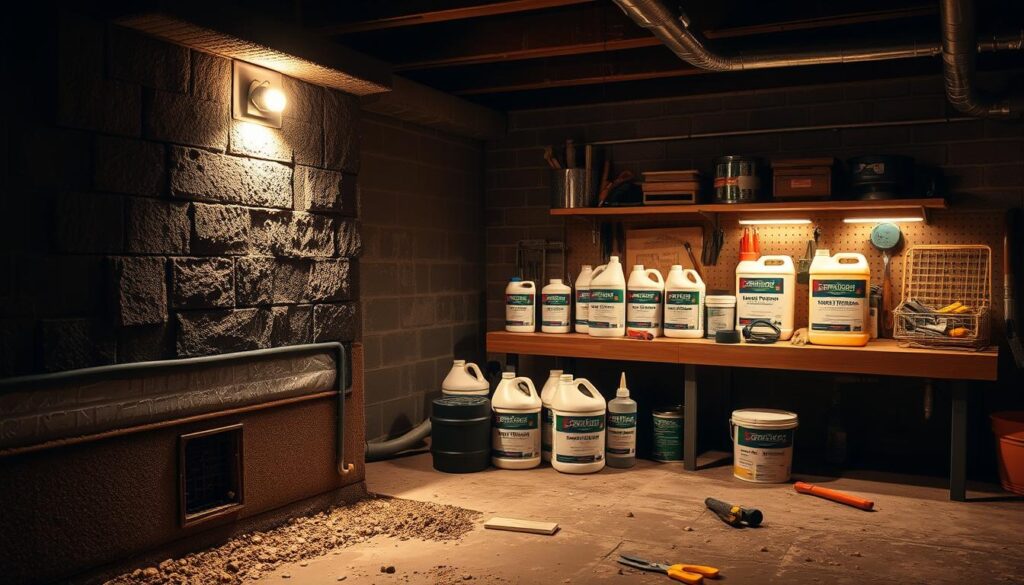
Top Waterproof Render Systems for Basement Walls
A dry basement begins with the right waterproof render system for your walls. When it comes to protecting your basement from water ingress, the render system you choose plays a crucial role in maintaining a dry and secure environment.
Sika-1 Pre-Bagged Waterproofing System
The Sika-1 Pre-Bagged Waterproofing System is a premium structural waterproofing solution that meets BS8102:2022 standards for all three grades of waterproofing. This system combines special cement and kiln-dried graded aggregates with waterproofing admixtures for superior performance.
Features and Benefits
This render system is available as a pre-bagged mortar, making it easy to mix and apply. The four different grades of mortar in the Sika-1 system cater to specific application requirements and durability needs, ensuring effective protection against water ingress.
Application Process
The application process involves thorough surface preparation, correct mixing ratios, and appropriate curing times to ensure the waterproofing system performs optimally.
Twistfix Tanking Slurry
Twistfix Tanking Slurry is a cost-effective barrier protection system for basement walls. It provides a robust waterproofing solution that is easy to apply.
Features and Benefits
This slurry is designed to create an effective barrier against water ingress while providing a suitable base for decorative finishes.
Application Process
The application involves applying the slurry to a prepared surface, ensuring a strong bond and effective waterproofing.
Essential Membrane Systems for Basement Waterproofing
Waterproofing membranes play a vital role in maintaining a dry and secure basement environment. Effective membrane systems are crucial for managing water ingress and ensuring the structural integrity of your basement.
Cavity Drain Membranes
Cavity drain membranes are a key component of Type C waterproofing systems, creating a drainage cavity between the structural wall and the membrane. This allows water to be channelled to drainage points, preventing accumulation.
Wykamol CM8 Membrane
Wykamol CM8 Membrane is a versatile 8mm high tanking membrane suitable for both above and below ground applications. Its studded surface and polypropylene mesh key facilitate direct application of plaster, render, or adhesive dabs for plasterboard dry lining.
Baseline Mesh Membrane
The Baseline Mesh Membrane features a polypropylene mesh surface, providing an excellent key for plaster, render, or plasterboard dry lining. This membrane is designed for durability and ease of application.
Floor Drainage Membranes
Floor drainage membranes, such as those with 20mm studs, create an effective drainage cavity beneath floor finishes, directing water to drainage channels and collection systems.
Wykamol CM20 Drainage Membrane
The Wykamol CM20 Drainage Membrane is designed for waterproofing basement and cellar floors, featuring 20mm studs that create a significant drainage cavity.
CM20 Hi-Viz Cavity Drain Membrane
The CM20 Hi-Viz Cavity Drain Membrane boasts a high-visibility yellow colour, aiding in proper installation and inspection. This membrane ensures a reliable drainage solution for basement floors.
Waterproof Render Basement Walls: Application Guide
To effectively waterproof render basement walls, it’s crucial to follow a systematic approach that ensures a durable and leak-free finish. This involves thorough surface preparation and the correct application of waterproof render.
Surface Preparation Requirements
Before applying waterproof render, you must prepare the basement walls adequately. This includes assessing and treating any existing damp issues, removing old plaster or finishes, and ensuring the surface is clean and dry. Different wall substrates, such as brick, concrete, or stone, may require specific preparation techniques to ensure optimal adhesion of the waterproofing system.
Application Techniques for Best Results
The application of waterproof render involves mixing the correct consistency of cement-based mortar and applying it in the recommended number of coats, allowing appropriate drying time between applications. It’s essential to follow the manufacturer’s instructions for the specific waterproofing product being used. After the final coat has dried, a renovation plaster can be applied to create a suitable surface for decorative finishes.
By following these guidelines and avoiding common application mistakes, you can achieve a long-lasting waterproofing solution for your basement walls.
Essential Accessories for Complete Waterproofing
A successful basement waterproofing project relies heavily on the right accessories to ensure a watertight seal. To achieve a completely waterproof basement, you need to consider the critical components that support your waterproofing membrane.
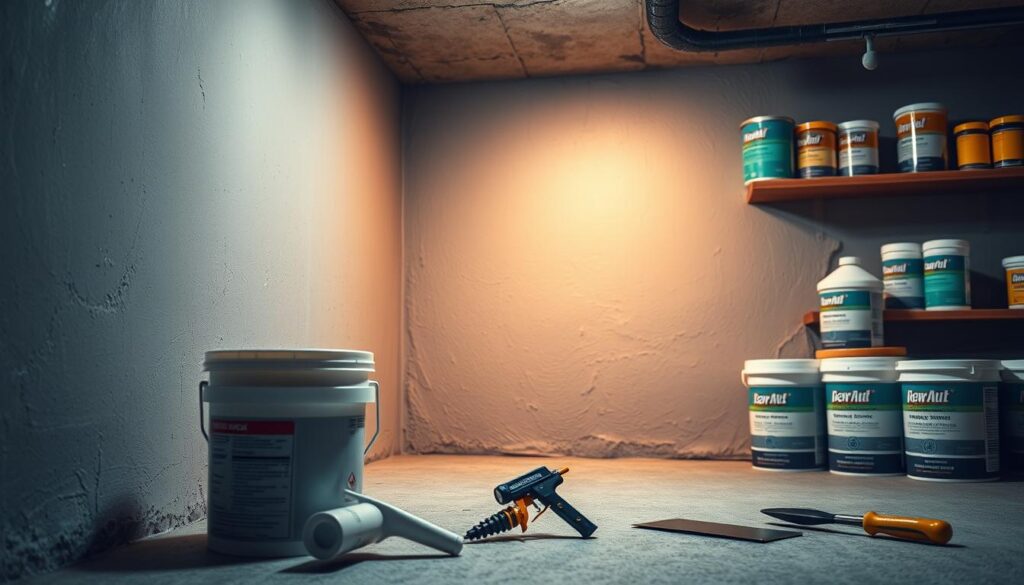
Waterproofing Tapes and Seals
Waterproofing tapes are crucial for sealing joints and ensuring a watertight seal. You can use butyl rubber tapes for sealing membrane joints and flexible tapes for wall-floor junctions. Proper sealing at critical points such as pipe penetrations, corners, and transitions between different materials is vital.
Fixing Plugs and Anchors
Fixing plugs and anchors are designed to secure waterproofing membranes to walls without compromising the waterproof barrier. Specialised products like waterproofing rope can be used for sealing around brick and plaster plugs when fixing tanking membranes.
Using compatible accessories from the same manufacturer ensures warranty coverage and system integrity. Additional waterproofing products such as overseal tapes, waterproofing putties, and fibre-faced sealing tapes are available for specific applications.
Choosing the Right Waterproofing Solution for Your Basement
Selecting the ideal waterproofing solution for your basement is a crucial step in ensuring a dry and habitable space. To make an informed decision, you need to consider several factors that influence the effectiveness of the waterproofing system.
Assessing Your Basement’s Specific Needs
To choose the right waterproofing system, you must first assess your basement’s specific needs. Factors such as the water table level, soil type, and existing moisture issues play a significant role in determining the most appropriate approach. A professional survey can help identify potential water ingress points and guide the selection of a suitable waterproofing method.
Budget Considerations and Long-term Value
When evaluating different waterproofing systems, it’s essential to balance upfront costs against long-term performance and potential return on investment. BBA-certified products that comply with BS8102 standards may offer higher initial costs but provide long-term benefits, including reduced maintenance and enhanced durability. Consider the expected lifespan of the waterproofing system and its impact on your basement’s usability.
When converting a cellar into a living space, an effective basement waterproofing system is crucial. Twistfix offers a range of top-notch, BBA-certified membranes and tanking products designed to meet BS8102 standards. By choosing the right waterproofing solution, you can ensure a dry, warm, and habitable basement that adds value to your property.
- Assess your basement’s specific waterproofing needs based on factors like water table level and soil type.
- Understand the importance of professional surveys in determining the best basement waterproofing approach.
- Evaluate different waterproofing systems based on your intended use of the basement space.
- Consider the cost implications and long-term performance of various basement tanking methods.
- Choose BBA-certified waterproofing products that comply with BS8102 standards for damp proofing.
By carefully evaluating these factors and considering the long-term benefits, you can select a waterproofing solution that meets your needs and enhances the value of your property.
Conclusion
To conclude, a comprehensive waterproofing approach ensures a dry and functional basement environment. You must choose the right waterproofing system based on your specific basement conditions and intended use. Proper installation of tanking systems is crucial for long-term protection against water ingress. Regular maintenance and inspection of your waterproofing system will help ensure its continued effectiveness, providing excellent long-term value by protecting your property through effective damp proofing measures.
